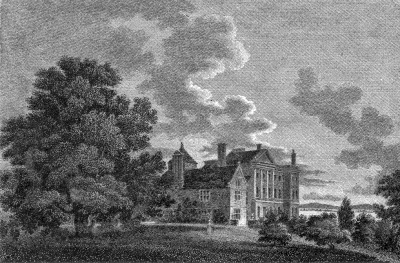| The
15th to the 18th Centuries |
| Allerton
was later held by the Lathoms of Parbold,
beginning with Edward de Lathom in 1441. Robert
Lathom of Allerton, who married a daughter of
William Norris of Speke, appears from 1472, dying
at a great age in 1516. He was succeeded by his
son William, then over sixty years old. The
Lathoms were both royalists and recusants (i.e.
Catholic), in common with many in the north-west.
Allerton Hall first seems to have appeared as
the home of Elizabeth Lathom, widow of Richard
Lathom, who had died in 1602. Her eldest son
Thomas died just before her in 1623 and the
estate passed to her second son Edward on her
death in 1624, and then to Thomas's son Richard
when he came of age in about 1643. Richard, a
Royalist, fought alongside his uncles in the
Civil War. He survived the war but the estate was
seized by Cromwell's parliament in 1652. |
| The manor
was sold to John Sumner of Midhurst in Sussex in
1654 for £2,700. However, the Lathoms, against
all the odds, managed to hold on to the estate
for some time and it was not until the beginning
of 1670 that Charles, son and heir of John
Sumner, obtained possession from Thomas Lathom by
a further payment. Later in the same year the
manor was sold to Richard Percival and Thomas his
son for £4,755. Richard Percival, born in 1616,
was a Liverpool businessman and alderman. He
refused to make the declaration required by the Test
and Corporation Act that he was a member of
the Established Church (i.e. protestant)
and was removed from his aldermanship in 1662. He
died in 1700, being succeeded by his other son
Richard, who had three sons and four daughters.
The eldest son, John Percival, failed in business
about 1722, and the father, apparently
overwhelmed by misfortune, retired to Manchester,
where he died in 1725. |
| In 1736 Richard
Percival, son and heir of John, sold the estate
for £7,700 to the brothers John and James
Hardman, the latter being distantly related by
marriage, and then retired to Wavertree Hall,
where he was living as a recluse in 1760 still
attempting to discharge of his father's debts. It
is likely that the present house originates from
the brothers' time. John Hardman, a merchant from
Rochdale, died in 1755 soon after his election as
MP for Liverpool, his brother James having
predeceased him in 1746. John had no children,
but James left three sons and a daughter, all of
whom died young, and the widow continued to
reside at Allerton Hall until her death in 1795. |
|
 |
| Allerton
Hall in the 18th Century |
| |
| This detail of an
engraving by S. Goodman from The Beauties of
England and Wales by John Britton, Vol IX
(1807), shows the relatively small original
Jacobean Hall from the time of Elizabeth Lathom
in the foreground. On the right is the newer
building work undertaken by the Hardman brothers
c.1740. Its completion by William Roscoe to give
the present symmetrical aspect involved the
demolition of the original hall. |
|